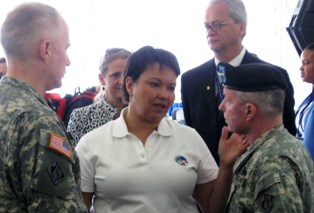(Originally Posted Feb 13, 2008)
When I first took command, I sat down with all of my senior leaders and developed the priorities and tenets that will drive this organization during my tenure. One of the tenets was to have transparent communication, and thanks to technology, that’s easier than I thought! So I’d like to dedicate my first posting to one of our Corps priorities – supporting the Global War on Terror.
A couple of weeks ago, I visited the Corps offices in Iraq and was able to tour a few of the projects our dedicated servicemembers, Civilians and contractors are working so hard on. I was there to mark the
Gulf Region Division’s (GRD) 4th anniversary in Iraq, and it was awe inspiring to reflect on how much this organization has done for Iraq and its people. With more than 800 Civilian and military personnel currently deployed to the region, we have completed more than 4,300 projects along side some 40,000 Iraqis. When talking with our teammates at GRD, I found that their experiences in Iraq have given them a new and positive perspective on life. I am humbled by their sacrifices.

We had big plans for the trip with lots of projects to see, but unfortunately, the weather had other things in mind, so we had to pass on some of our original scheduled site visits. But in addition to our time in Baghad at GRD, I was able to visit Balad Air Base and As Sulaymaniyah.
One project I’d like to talk about is the renovation of Cham Chamal Prison in As Sulaymaniyah, in northeast Iraq. The facility was built years ago under Saddam Hussein, who used it as a prison to lock away thousands of Kurds; still a very sensitive subject for the Kurdish people in the region. Today, a Kurdish contractor is doing the renovations and upgrades, and work is well under way and on schedule, to make it into a high security confinement facility that the government of Iraq can use for years to come.
But one thing you just don’t see much of in the mainstream media, is the quality of life improvements I was able to see first hand: busy streets, markets overflowing with fruits and vegetables, and people going about their daily routines – all very positive signs of progress for that region.
Throughout Iraq, there is major progress to report. The country has more capacity to generate power today than during the Saddam Regime, and we’re spreading it more equitably across the country. Our efforts have almost doubled Iraq’s ability to generate power. There are families in Anbar Province that have never had power before – and now they do! Essential services, like hospitals, water sewage pump stations and fire stations have power 24 hours a day. There’s a 3 tiered approach to distribution, which is that first, essential services get power, then what remains is filtered to the government buildings, and then to the residents and private businesses, so that’s why some people, in Baghdad for example, who used to get power all the time, are experiencing less than before – but throughout the country it is a major improvement.
Add to that the fact that we are chasing an ever-changing goal – demand has increased more than 70 percent since 2004 because Iraqis are purchasing more energy-intensive products such as air conditioners, refrigerators, computers and other electronics. This is a good thing! It means the economy is growing stronger.
I was really disappointed that we were unable to visit the Basrah Children’s Hospital, which was one of the stops nixed for weather issues. But, the progress there is really promising – it’s now close to 80% complete. Along with
Project HOPE, we are committed to complete the hospital project on schedule, and I am going to try again next time to be able to see it in person.
Looking ahead to the future, we remain committed to integrating Iraqi women and women-owned businesses as a component of building the workforce and infrastructure as Iraq gets closer to managing all of these services on its own.
In my view, winning in Iraq and Afghanistan takes more than military efforts alone. The work our leaders and teammates are doing on the infrastructure, in direct coordination with the Iraqi ministries, is building capacity and strengthening their own capabilities. I am extremely proud of the men and women of the Corps, who have a key role in this fight.
Thanks for letting me share my thoughts with you. I look forward to the dialog!
Best, Van
ltg.van Contingency Operations, Corps Projects, Infrastructure, International and Interagency Services, Iraq, Military Programs Anbar Province, As Sulaymaniyah, Balad Air Base, Basrah Children's Hospital, Cham Chamal Prison, Deployment, Gulf Region Division, Iraq, Kurdish people, Power, Project Hope, Reconstruction, Schools, Water



